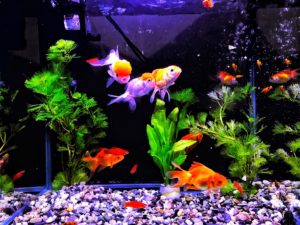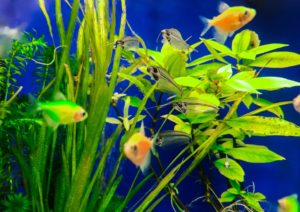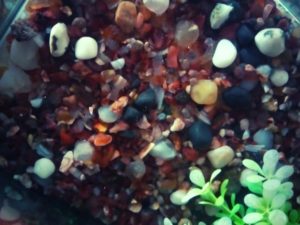The environment for aquarium fishes can vary. It depends on the type of fish and what you want from an environment. The requirements for a freshwater fish are different from those for saltwater fish.
Some fish require a pH of 6.0 to 8.0, others need a pH level between 7.5 and 8.4, while still others are fine with a pH of 5.8 to 7.2 or so on the acidic side of the scale. The fishkeeper needs to research what fish will live well in the pH range of his or her tap water.
There are several ways to change the pH level of the aquarium, but these methods take time and need to be done gradually.
Before setting up a new aquarium it is important to know what type of habitat the desired fish needs. Some species live in warm shallow ponds while others prefer cold deep streams.
Ponds are usually very calm with quiet waters. Streams, on the other hand, can be full of rapids and waterfalls. The types of plants and animals found in a stream or pond will vary depending on such factors as where it is located (near the sea, for example) and how much rainfall there has been lately (more rain will result in a larger, faster stream).
Aquarium water
Aquarium fish need water in appropriate conditions to survive. Plants and fish produce chemical wastes, so fish need their environment to be filtered. But fish also produce ammonia when they eat for protein. Ammonia is toxic in high concentrations so fish need an environment where ammonia can dissipate. In fish tanks, fish produce fish waste which causes more ammonia to be produced. Ammonia can kill fish, so fish keeper needs to clean their fish tank and change some of the water within every week.
Fishkeeper needs to use distilled or RO (reverse osmosis) water for aquariums because tap water usually has chemicals that fishkeeper does not want to use with aquariums.
Is excessive algae growth is harmful?
Algae is a plant-like organism that absorbs the light and CO2 from the air and water, which it uses to create oxygen and sugar. Growth of algae should not be excessive, but moderate. If the growth is excessive than this may indicate other problems such as overfeeding. This can cause fish to become obese and insulin resistant which can lead to diabetes. This can also lead to fish having low amounts of vitamins A and D, causing blindness and connective tissue diseases.
Excessive algae growth can be caused by fish overfeeding, which in turn is caused by poor fish management. If fish are overeating, they will continuously produce more ammonia which in turn allows the algae to grow faster. Maintaining good water quality through regular partial water changes and ensuring proper feeding amounts for fish is important when trying to reduce excessive algae growth.
Cause Of Excessive Algae
Another cause of excessive algae growth is low fish stocking levels, small fish usually eat a lot more than larger fish do. If fish are not eating all the food that they should be then the food will end up in the substrate which in turn causes excess nutrients for algae to feed on. Ensuring good fish stocking levels and feeding practices is important in fish health.
Be sure to check fish for signs of disease if fish are unhealthy due to excessive algae, fish could be stressed and will not be able to fight off diseases. Parasites may also become an issue which can affect fish health. Usually healthy fish, that eat a normal amount of food, don’t experience this kind of problem.
Algae should be controlled to prevent fish health issues, which can in turn affect fish population numbers. There are many fish food types available at the pet store that contain ingredients designed to control algae growth in fish tanks.
What do fish eat?
Fish are cold-blooded creatures in that they need to live in water or otherwise their body temperature would rise. They do not have sweat glands, so they cannot perspire to cool themselves down. Instead fish are able to absorb heat from the water around them, which cools their bodies down. This is what keeps fish alive! The fish you see in aquariums or fish tanks are fed fish food by fish keepers, who also monitor the tanks and make sure everything stays clean.
The fish’s natural habitat is fresh water – either freshwater sources like lakes and streams, or saltwater sources like the ocean – but fish can live in other habitats too. Few fish can survive in very polluted water, though fish living along coastlines have probably evolved ways to deal with oils from ships and fish waste from fish farms. Some fish in the Amazon River in South America have a type of natural sunscreen that protects them from the sun, which is very strong in that area.
What do fish Eat in an aquarium?
What fish eat depends on the fish. Some fish are picky about what they will eat while some fish will eat almost anything you put in the tank! Some fish prefer live food while others do not. Fish who enjoy live food might be more prone to disease if fed live fish, so it is best to feed them fish food. Fish will also eat fish waste, which is called fish ‘flakes’.
Fish are supposed to eat fish food flakes or pellets. Some fish are more sensitive to the fish food they are given, especially if it contains too much fish oil or fish meal. Be sure to check for signs of fish stress when giving them new fish food, fish could be stressed and this will make them more susceptible to fish diseases.
Fish Flakes
Fish eat fish flakes or fish food pellets in an aquarium, but fish also eat fish food flakes when they are outside their home too! Fish usually eat fish food several times a day, though some fish will only eat once or twice. Fish food will make fish grow, but fish living in cool water can eat fish flakes two or three times a day without growing too fast.
Fish are supposed to eat fish flakes or fish food pellets – fish that only eat fish flakes could be sick! Some fish might not like certain kinds of fish food pellets, though they probably will not eat fish food that is too fishy either. Fish flakes or fish pellets usually do not contain everything fish need to stay healthy, but fish can eat fish flakes all their lives as long as they are given a variety of foods as well.
Intervals Of Fish food
Fish are supposed to eat fish flakes or fish food pellets twice or three times a day! Fish should be able to eat fish flakes without fish flakes getting stuck in their mouths because fish food pellets are supposed to dissolve easily. Fish can eat fish flakes all the time, but fish should also be given a variety of fish food types as well!
Tropical fish
Tropical fish are fish that live in tropical climates. Tropical fish possess physiological features that allow them to survive in the warm water, which makes it easier for them to be kept in home aquariums. Some fish species are able to better withstand environmental changes when they are kept in captivity, while others need a stable environment to be comfortable.
Fish species
There are fish that can be kept in fish bowls or small fish tanks, while others need a larger fish tank with plenty of swimming space. Some fish, on the other hand, require large fish tanks because they swim at the top level of the water. These fish also have to be fed frequently and some fish require a fish tank that contains plants. Some fish need a fish tank with a heater, while others can be kept in fish tanks with air pumps.
Fish species survival
Fish have different environmental requirements, which is why it can be difficult to set up an environment that provides fish with everything they need. Fish are able to adapt to changes in the fish tank’s environment, but only if these changes are not too extreme. If fish are exposed to dramatic changes in their fish tank’s temperature, they can suffer from fish stress.
There are fish species that prefer to live in fresh water tanks, while others feel most comfortable when they are kept in salt water fish tanks. Some fish require rocks or plants for cover, while other fish are able to survive without any hiding places
Betta fish
The betta fish is also known as the Siamese fighting fish. They have been bred to have many varieties of colors and patterns. They are originally from Thailand, Malaysia, Vietnam and Cambodia. They can also live in puddles, rice paddies and slow moving waters.
Betta fish are great fish to have because they are easy to care for fish with long lives. The betta fish normally lives over 3 years but some have lived up to 10 years. These fish are mouth brooders. This means that the male fish takes care of the eggs and has a bubble nest for them to be in. The betta fish is a carnivore fish so they normally eat live food such as brine shrimp, crustaceans, blood worms and daphnia.

